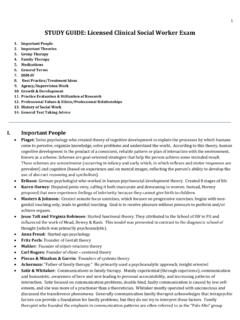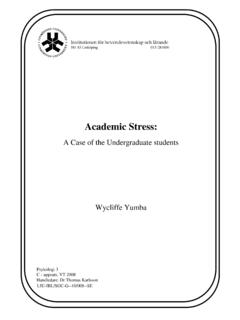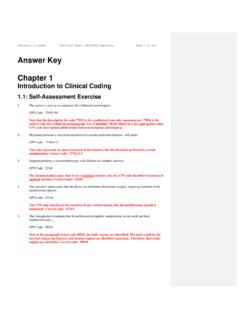Transcription of Coding Companion for Podiatry
1 2016 Coding Companion forPodiatryA comprehensive illustrated guide to Coding and Page 1 Friday, November 21, 2014 3:06 PMCoding Companion for Page i Friday, November 21, 2014 3:06 PM28043-28045 [28039,28041]Excision, tumor, soft tissue of foot or toe, subcutaneous; less cm or greater28039 Excision, tumor, soft tissue of foot or toe, subfascial (eg,intramuscular); less than cm or greater28041 ExplanationThe physician removes a tumor from the soft tissue of the foot or toe that islocated in the subcutaneous tissue in 28039 and 28043 and in the deep softtissue, below the fascial plane, or within the muscle in 28041 and 28045. Withthe proper anesthesia administered, the physician makes an incision in theskin overlying the mass and dissects down to the tumor. The extent of thetumor is identified and a dissection is undertaken all the way around the portion of neighboring soft tissue may also be removed to ensure adequateremoval of all tumor tissue.
2 A drain may be inserted and the incision is repairedwith layers of sutures, staples, or Steri-strips. Report 28043 for excision of asubcutaneous tumor whose resected area is less than cm and 28039 for aresected area that is cm or greater. Report 28045 for excision of a subfascialor intramuscular tumor whose resected area is less than cm and 28041 fora resected area cm or TipsCodes 28039 and 28041 are resequenced codes and will not display in numericorder. Local anesthesia is included in these services. However, these proceduresmay be performed under general anesthesia, depending on the age and/orcondition of the patient. An excisional biopsy is not reported separately whena therapeutic excision is performed during the same surgical session. If aspecimen is transported to an outside laboratory, report 99000 for handlingor conveyance.
3 For radical resection of a tumor, soft tissue of foot, see28046 28047. For excision of cutaneous, benign lesions, see 11420 exploration of blood vessels, nerve repair, and complex repairs arereported DiagnosticMalignant neoplasm of connective and other soft tissue of lowerlimb, including melanoma of skin of lower limb, including neoplasm of lower malignant neoplasm of other specified cell carcinoma of the lower Merkel cell of other skin and subcutaneous benign neoplasm of connective and other soft tissue of lowerlimb, including of uncertain behavior of connective and other soft of unspecified nature of bone, soft tissue, and Equivalent CodesN/ATerms To or nonmalignant in sheet or band of tissue that envelops organs, muscles, andgroupings of tumor containing fat cells and the most common of soft tissuelesions, which are usually painless and asymptomatic.
4 With the exception ofan condition tending to progress toward death, specifically aninvasive tumor with a loss of cellular differentiation that has the ability tospread or metastasize to other areas in the EditsMUES tatusFUDNon-Fac RVUFac RVU3(1) (1) ReferenceModifiersNone80N/A50512803980*N /A505128041N/AN/A50512804380*N/A50512804 5* with documentationCPT 2015 American Medical Association. All Rights Reserved. 2015 Optum360, LLCC oding Companion for Podiatry154 Foot and ToesFoot and Toes36415 Collection of venous blood by venipuncture36415 ExplanationA needle is inserted into the skin over a vein to puncture the blood vessel andwithdraw blood for venous collection. The blood is used for diagnostic studyand no catheter is examination; tibia and fibula, 2 views73590 ExplanationTwo films of the lower leg bones are taken.
5 The physician interprets and reportsthe examination, ankle; 2 views73600complete, minimum of 3 views73610 ExplanationTwo films are taken of the ankle in 73600 and a complete radiologic exam ofthe ankle is performed in 73610 with three or more films taken. The codes donot specify that a specific view must be performed. The physician interprets andreports the examination, ankle, arthrography, radiological supervisionand interpretation73615 ExplanationThe physician injects radiopaque fluid into the ankle for arthrography. Thephysician inserts a needle into the joint and aspirates if necessary. Opaquecontrast solution is injected into the ankle and the needle is removed. Films arethen taken of the ankle. This code reports the radiological supervision andinterpretation only. Use a separately reportable code for the examination, foot; 2 views73620complete, minimum of 3 views73630 ExplanationTwo films are taken of the foot in 73620 and a complete radiologic exam of thefoot is performed in 73630 with three or more films taken.
6 The codes do notspecify that a specific view must be performed. The physician interprets andreports the examination; calcaneus, minimum of 2 views73650 ExplanationTwo or more films are taken of the calcaneous or heel bone. The physicianinterprets and reports the examination; toe(s), minimum of 2 views73660 ExplanationTwo or more films are taken of the toes. The physician interprets and reportsthe tomography, lower extremity; without contrast material73700with contrast material(s)73701without contrast material, followed by contrast material(s) andfurther sections73702 ExplanationComputed tomography (CT) directs multiple narrow beams of x-rays aroundthe body structure being studied and uses computer imaging to produce thincross-sectional views of various layers (or slices) of the body. CT is useful for theevaluation of trauma, tumor, and foreign bodies as CT is able to visualize softtissue as well as bones.
7 Patients are required to remain motionless during thestudy and sedation may need to be administered as well as a contrast mediumfor image enhancement. These codes report an exam of the lower 73700 if no contrast is used. Report 73701 if performed with contrastand 73702 if performed first without contrast and again following the injectionof resonance (eg, proton) imaging, lower extremity other thanjoint; without contrast material(s)73718with contrast material(s)73719without contrast material(s), followed by contrast material(s) andfurther sequences73720 ExplanationMagnetic resonance imaging (MRI) is a radiation-free, noninvasive, techniqueto produce high quality sectional images of the inside of the body in multipleplanes. MRI uses the natural magnetic properties of the hydrogen atoms in ourbodies that emit radiofrequency signals when exposed to radio waves within astrong electro-magnetic field.
8 These signals are then processed and convertedby the computer into high-resolution, three-dimensional, tomographic with metallic or electronic implants or foreign bodies cannot be exposedto MRI. The patient must remain still while lying on a motorized table withinthe large, circular MRI tunnel. A sedative may be administered as well as contrastmaterial for image enhancement. For lower extremity other than joint, report73718 if no contrast is used; 73719 if performed with contrast; and 73720 ifperformed first without contrast and then again following the injection resonance (eg, proton) imaging, any joint of lower extremity;without contrast material73721with contrast material(s)73722without contrast material(s), followed by contrast material(s) andfurther sequences73723 201 Optum360, LLCCPT 201 American Medical Association.
9 All Rights 315 Coding Companion for PodiatryAppendixCPT 2015 American Medical Association. All Rights Reserved. 2015 Optum360, LLCC oding Companion for PodiatryEvaluation and Management 383 Evaluation and ManagementEvaluation and ManagementThis section provides an overview of evaluation and management (E/M) services, tables that identify the documentation elements associated with each code, and the federal documentation guidelines with emphasis on the 1997 exam guidelines. This set of guidelines represent the most complete discussion of the elements of the currently accepted versions. The 1997 version identifies both general multi-system physical examinations and single-system examinations, but providers may also use the original 1995 version of the E/M guidelines; both are currently supported by the Centers for Medicare and Medicaid Services (CMS) for audit some of the most commonly used codes by physicians of all specialties, the E/M service codes are among the least understood.
10 These codes, introduced in the 1992 CPT manual, were designed to increase accuracy and consistency of use in the reporting of levels of non-procedural encounters. This was accomplished by defining the E/M codes based on the degree that certain common elements are addressed or performed and reflected in the medical Office of the Inspector General (OIG) Work Plan for physicians consistently lists these codes as an area of continued investigative review. This is primarily because Medicare payments for these services total approximately $ billion per year and are responsible for close to half of Medicare payments for physician levels of E/M services define the wide variations in skill, effort, and time and are required for preventing and/or diagnosing and treating illness or injury, and promoting optimal health. These codes are intended to represent physician work, and because much of this work involves the amount of training, experience, expertise, and knowledge that a provider may bring to bear on a given patient presentation, the true indications of the level of this work may be difficult to recognize without some first glance, selecting an E/M code may appear to be difficult, but the system of Coding clinical visits may be mastered once the requirements for code selection are learned and AMA advises coders that while a particular service or procedure may be assigned to a specific section, the service or procedure itself is not limited to use only by that specialty group (see paragraphs 2 and 3 under Instructions for Use of the CPT Codebook on page xii of the CPT Book).









